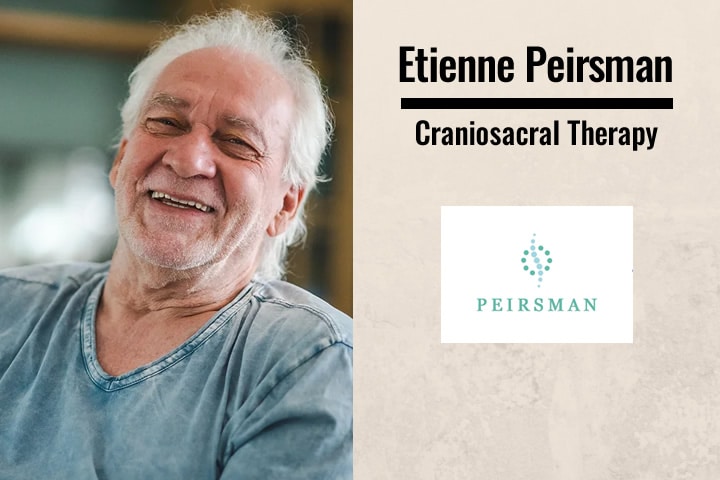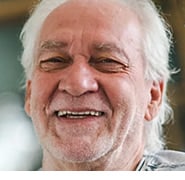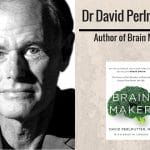Watch the full interview below or listen to the full episode on your iPhone HERE.
Stu: This week I’m excited to welcome Etienne Peirsman to the podcast. Etienne Peirsman is one of the most respected CranioSacral teachers worldwide, and has been teaching for nearly 35 years. He founded Peirsman CranioSacral in the Netherlands, originated the CranioSacral Professional Organization in Holland, and is an honorary member of The Dutch CranioSacral Practitioner Association.
Audio Version
Some questions asked during this episode:
-
What is craniosacral therapy?
-
What does a typical craniosacral session look like?
-
What’s the relationship between healing and human connection?
Get more of Etienne Peirsman:
- https://www.peirsmancraniosacral.com/
- https://www.facebook.com/peirsmancranio
If you enjoyed this, then we think you’ll enjoy this interview
Louloua Smadi – Neurofeedback Therapy To Optimise Your Brains Potential
Dr Valdeane Brown PhD – Training the brain for more focus and clarity
Dr Stan Rodski – The Neuroscience of Mindfulness
The views expressed on this podcast are the personal views of the host and guest speakers and not the views of Bega Cheese Limited or 180 Nutrition Pty Ltd. In addition, the views expressed should not be taken or relied upon as medical advice. Listeners should speak to their doctor to obtain medical advice.
Disclaimer: The transcript below has not been proofread and some words may be mis-transcribed.
Full Transcript
Stu
(00:03)
Hey, this is Stu from 180 Nutrition, and welcome to another episode of the Health Sessions. It’s here that we connect with the world’s best experts in health, wellness, and human performance in an attempt to cut through the confusion around what it actually takes to achieve a long=lasting health. Now, I’m sure that’s something that we all strive to have. I certainly do. Before we get into the show today, you might not know that we make products too. That’s right, we are into whole food nutrition and have a range of super foods and natural supplements to help support your day.
(00:33)
If you are curious, want I find out more, just jump over to our website. That is 180nutrition.com.au and take a look. Okay, back to the show. This week, I’m excited to welcome Etienne Peirsman to the podcast. Etienne is one of the most respected craniosacral teachers worldwide and has been teaching for nearly 35 years. He founded Peirsman Craniosacral in the Netherlands and is an honorary member of the Dutch Craniosacral Practitioner Association. In this episode, we discuss the principles behind craniosacral therapy, the conditions that are most commonly treated, and the method to achieve a no mind state. Over to Etienne. Hey, guys. This is Stu from 180 Nutrition and I am delighted to welcome Etienne Peirsman to the podcast. Etienne, how are you?
Etienne
(01:25)
I’m totally fine.
Stu
(01:26)
Fantastic. Again, thank you so much for sharing some of your time. I know you’ve got an incredible story and really, really interesting subject that I know that our listeners would love to hear and understand and figure out a little bit more about how this amazing stuff actually happens. First up, for all of our listeners that may not be familiar with you or your work, I’d love it if you could just tell us a little bit about yourself, please.
Etienne
(01:54)
Well, I’ve been teaching craniosacral therapy for as long as I remember. Actually, it started in 1990. That’s an exact date. I still remember that. I’ve been doing nothing else since then. I had a practice for about 20 years. Then while I was teaching also, but the rest of the time up to now I just teach craniosacral therapy a little bit all over the world. We just came back from Taiwan where we taught a month, and then we go to Mexico next week for a 10-day class, Italy, Prague, the Netherlands, and US, of course. I published one book about craniosacral. I happen to have it here next to me. It’s Craniosacral Therapy for Babies and Small Children. That’s a little bit the only book that’s available about that subject. Soon, another one is going to come out a little more about also craniosacral, of course. I’m just teaching craniosacral. That’s what I do.
Stu
(03:18)
Craniosacral therapy or cranio, I wasn’t hugely familiar with it. Then I started to dig a little bit deeper and realized that boy, it’s very, very powerful therapy and has roots in mindset, human touch, being present in the moment. It almost goes against the grain of the modern day society, which is complete infatuation with social media and internet and no physical communication, all of those things. For our listeners then like me who aren’t, or maybe not be familiar with cranio, tell us about the principles of cranio, please.
Etienne
(04:04)
Well, what it actually is, it is putting people in meditation and the practitioner also goes in meditation. When we do craniosacral, the way to do it is you yourself as a practitioner have to go in no mind where you stop thinking. Of course, when you do that, and we have our ways to connect to a client with instant mindfulness, I call it, with conscious touch. The client also goes, he follows, they both follow you in no mind. No mind, it sounds a bit strange. You have to realize that the body, every night when you go into deep sleep, you go in the same space and that’s where your body is going to replace billions of cells every night. When you wake up tomorrow, your body has changed so much and you also probably know in 84 days, you have a whole new body.
(05:21)
It is not something like, wow, what are we doing? No, it is something really essential, something that the body already does. The effect of what we are doing is opening up the diaphragms, the different diaphragms in the body so that the life force, and for us, the life force is related to the free flow of craniosacral fluid inside of the spinal column. There is a big membrane inside of the spine, the dura mater we call it. In there is the spinal cord. Then that membrane also goes into the brain on the inside of the skull. The brain lives there. What we do is give space to the skull so the brain has more space to do its job and the same thing we do with the spine, so the spinal cord also has maximum space. That’s the center of the body. It regulates the body. If your computer has more space to do its work, the rest of the body will follow instantly. It sounds a bit like wow, we are going into a brain, but we really do and we enjoy it also.
Stu
(06:54)
In terms of the people that you treat from maybe a condition perspective, so what type of conditions would commonly be treated with cranio and who would come to see you?
Etienne
(07:08)
Well, not people that do heavy, heavy work. Their muscles are too tight, they need to be loosened up a little bit. Anything, babies, small children, children with learning disabilities, people with anxiety. Almost the whole population. People that can’t get out of their head, out of their mind and people with all kinds of trauma, mental things that they can’t solve. One part of our work is just hands-on silent work where we open the body. Then when you go into that space where we work, every trouble starts coming up. If there is a physical thing, people will start telling about it and we feel it also. If there is emotional or mental stuff that people are sitting with, it’ll come to the surface.
(08:13)
We have a way of bringing the original energy back in the body and that pushes everything that’s not clear to the surface. That’s basically, I think the best way to describe it. Everything that is not clear in the client will automatically surface and then we can deal with it. Part of it is talking with the client, but not just like you and I are talking. It is when the client, his eyes close on the table and they’re in that deep, deep dream. You bring literally a client in dream time where your aboriginals talk about, that’s, that no mind space. Then you talk to them from that perspective and they answer from that same place. It goes much deeper than just talk therapy because that’s mind. That’s mind talking to mind. We go literally in the intelligence that created the mind and the body, that’s where we operate.
Stu
(09:33)
What would a typical session look like in terms of if I were going to see a physiotherapist, I would sit down and they would make some adjustments and feel muscles and move limbs, things like that, what would I expect if I came to see you and had a session?
Etienne
(09:49)
Well, that is so different. When we touch, we almost don’t move. We touch certain places and then we just wait. There is a few magical things that we do, very scientific, actually. When you touch, like a physical therapist, he’s going to move. When you touch this way, when you just put your hand on somebody’s hand or anywhere on the body and you just wait, we just don’t wait like that. We become conscious about, okay, what is this finger feeling and this one and this one and this one? We really, really connect and we start feeling totally. The result of that is instant mindfulness. You become so engaged in feeling that you can’t think anymore. Of course, we have been trained in our training, that’s where we focus on that mindfulness. That’s not the only thing. We have a few tricks, like when you loosen your jaw while you do that, when you have your jaw closed, these muscles, they start working to hold that and that produces stress hormone in the brain.
(11:21)
When you relax that, stress hormone mode disappears and you go into a deeper state, actually a state of no mind. It’s a meditation technique just to loosen your jaw. Then on top of that, after a minute of touch, both bodies, the client and the practitioner, both body starts producing oxytocin. That is a hormone that mom and baby produce also. It creates the love bond between them. Something that can be broken. If there is enough oxytocin, mom and baby are a unit for the rest of their life that, that love just happens. When we touch that way, the same deal happens. The client practitioner both start producing that hormone. You can say it’s the love hormone, but what it does, it creates oneness in the sense that the client and the practitioner, both bodies become one pool of energy. There is a huge amount of energy available, much more than when you go to sleep on your own and you go into that deep healing space. We just have so much energy available that healing becomes natural. It’s unavoidable. Let’s put it like that.
Stu
(13:02)
The no mind state, I’d love to understand a little bit more about that. Because meditation hopes to ultimately get you into the present, being as mindful as you can. Many people, myself included, find meditation almost impossible. The mind just will not shut up. Monkey mind continuously 24/7. Even sometimes during the night where you’re waking up and then you have these thoughts that continue to ruminate. No mind would just be nirvana for me, and I would imagine for lots of people. How would we get there?
Etienne
(13:41)
Well, I just explained. It is that simple. There, as a practitioner, the only thing you have to do is nothing. You just touch and the oxytocin is one aspect of bringing you in that no mind space. Just one aspect. The second aspect is to lower your jaw. As a practitioner, you don’t produce stress hormone. Then there is another thing besides the conscious touch and loosening your jaw, and that is something we call midline. Now, midline is something that appears at the very beginning or after conception. It’s a little explanation, but I can’t, otherwise it will not make sense. When an egg is fertilized, you have one cell. Now, that one cell that’s basically the mother of all stem cells. It is so small you need a microscope. That one cell goes on to create your body and my body.
(15:03)
The way that it does it is it starts to clone itself until there is a magical number, you could say, a certain amount. Then it starts to organize itself in three different layers of stem cells. They will go on, one layer will produce the outside of the body, the part of the body that connects to air. Another part will create the inside of the body, the organs. Then the third layer will create the connective tissue. All the different tissues in the body are at that moment present in three layers of stem cells, which means you cannot say a nose or an ear or an eye or a finger. It is just little cells that have no form yet. They’re like drops of water, but they have immense potential. Then a line appears in the middle, it’s like three pancakes and then a line appears.
(16:19)
If the line doesn’t appear, the pancakes will close and start create a ball with eyes and ears and maybe a bone here and there, but something that cannot be alive. It’s just pure chaos. Now, when that midline appears, suddenly, all the stem cells get clarity of purpose. They suddenly know what they need to do, how to become what they’re destined to become. Like a stem cell will suddenly realize, “Oh, I have to be a lung cell.” Another one, “Oh, I’m going to be heart cell or an eye cell.” The clarity of purpose suddenly is there. Then the second thing is the clarity of where they have to migrate to. That midline brings clarity on all levels to every cell in the body. One of the things that happen in no mind is time disappears.
(17:34)
When you really get into meditation, there’s no time. When you really go in deep sleep, there is no time either. It is just blackness. You go into it and you wake up hours later. No time, no idea about self either. It’s just empty. Now, it’s that same space with the midline. The midline, time disappears, and at the same time, when time disappears, all the cells realize their purpose. It’s like an instant, instant remembering of what everybody needs to do. It creates clarity on a physical level, but also, the clarity on a mental and emotional level. Everything that’s not clear will rise. Now, that doesn’t really explain no mind, but that’s what happens. It can only happen if there is no thought, otherwise all the energy goes there. Now, with meditation, no mind is so difficult because you’re on your own and you just sit there
(18:52)
Of course, your mental thing that is not in order is going to try to figure itself out. That only happens after 30 years, after your brain is so bored of doing this, suddenly, it stops syncing with our touch. That’s the magic of cranio, it’s instant. When I have a client, even somebody that never, ever, ever had craniosacral or meditated, we touch for about 10 minutes and we are of course, trained to go in there. It’s something that you can learn in the first class. The first day we introduce that, and the second day everybody goes in that same space. It is so easy to learn. The magic is that you’re not alone. You have, because of the oxytocin, there is so much energy available that we trick the brain in thinking it’s time to go into deep sleep. We just trick the brain and the mind just turns off because it’s cleaning time. If it’s cleaning time, you cannot use the mind if it needs to be cleaned. It’s like a car. You guys still drive Hunter or Humber or whatever it’s called, or Volkswagen.
Stu
(20:27)
Volkswagens, absolutely.
Etienne
(20:30)
If you need to clean the engine, you have to turn it off.
Stu
(20:34)
You do. Yes.
Etienne
(20:36)
The same is with that overload of energy. We trick the mind in thinking that, hey, sleep time, and it just turns off. It’s that simple.
Stu
(20:47)
My word. I would love to sit down for an hour with you in the same room. I’d be your biggest case study, for sure.
Etienne
(20:59)
Oh, my God. That would be wonderful.
Stu
(21:01)
I had a conversation years back with a chap called Dr. Bruce Lipton. He was talking about stem cells. He was the first biologist, I think, to actually manage to grow stem cells outside of the human body. The conversation that I remember, and it was so profound, went along the lines of he tried for years to try and grow stem cells outside of the human body in these Petri dishes. Every single time, the stem cells would die. Then he realized that the culture in the stem cell was so absolutely important in order to make the stem cells grow. He likened the human body to a Petri dish, and he said that our mind controls our bodily Petri dish in terms of the chemicals and the hormones that are released by thought.
(21:57)
If we’re thinking, if we are in a space of fear and anxiety and negativity, then we’ve got stress hormones flowing through our body. If we’re in a space of love and forgiveness and happiness, then we have got all of these life-giving hormones. You mentioned oxytocin, dopamine. He said that was the pivotal shift for him because when they changed the Petri dish, the matter in the Petri dish, he said the stem cells flourished. He said, the power of your thought can do the same thing in your body because you are essentially resetting the Petri dish.
Etienne
(22:35)
Yes. Well, I don’t agree with him.
Stu
(22:39)
Yeah. Go on, then.
Etienne
(22:48)
It’s the power of no mind, not the word of the mind.
Stu
(22:48)
Yes.
Etienne
(22:48)
No mind is so fast and stem cells live in no mind. If you have a specific idea, you limit what is possible. If you don’t have an idea, then there is this openness and stem cells know much better than we do what they need to do. Now, the other thing, we do the same with stem cells. We grow them, but inside of the body, why take them out and grow something outside if you can do it inside of the body? One of the things that is so interesting, and I had a few, not just one but, a few people. One was a graduate, one was a teacher, and they had a hemorrhage in the brain, bleeding and of course, paralyzed. With the teacher, sorry, it took maybe four or five sessions. She was half paralyzed. To recreate, to clean the brain and to repair the brain. In three, four sessions, she was at the time aren’t talking. She couldn’t use one arm at all. Within a few sessions, the brain was repaired and healed again. It is something that we use regularly in the body.
(24:36)
Every organ in the body has its own stem cells that are specific to that organ. Like the heart for instance, it has a little, and it’s like a little layer of fat. Very small and very special fat. Their stem cells live there because every night, every organ needs to be repaired. It’s an ongoing creation of our body. Our body is never finished. Some cells, like blood cells live three weeks, so they need to be repaired every time. Now, one of the things we do with blood, we go, for instance, when we open up a diaphragm here, which is a place where the shoulders come and we connect to the breast bone. One of the things we do, and that’s part of our conscious touch, we put our fingers on the skin. Then when you put your fingers on the skin, there is this whole thing that we learned in class, which is what skin is all about. It is the membrane around the very first cell that became alive. It’s not only that membrane, the membrane also had to become aware of what is food in the ocean and what is danger.
(26:14)
Skill has to do with staying alive, with survival. It is our body, our species is so good at survival, yet that evolution becomes possible. Also, if you start your life, you start as one single cell, just like a single cell in the ocean, the beginning of life. In your mom’s belly, you go through the whole evolution of life. You become a fish-like thing, then a reptilian thing, then a mammalian, and finally, human. You go through the whole evolution. Now, that’s conscious touch, but we don’t think that we know that. When you connect with skin, that whole thing suddenly is there available, the knowing what skin is all about. Then we go into the bone, the breast bone, and that’s where cells are living, are being created. That’s where stem cells live to create blood cells. We just connect to them. You cannot connect to them with the mind. Then you’re away from what they really are. They operate on pure intelligence, not mind-created intelligence, but cosmic intelligence.
(27:52)
The intelligence that created life. When you go into no mind, you become part of their level. You raise yourself to their level where they are. That’s the magic of them. If something needs to happen, they know the very instant you realize something needs to happen. They know because they’re at the same level. They know even almost before you know what needs to happen in the client’s body. They know and they started already. That’s the amazing thing of stem cells in the body. There is this instant, and this leads also to Zen, almost. There is nothing else that now, and now everything is happening. Stem cells are the cells that are really in the here and now. When you realize something as a client or as a practitioner, stem cells know it immediately. They are so present that there is no barrier. The barrier, you can have a barrier if you think about it. Then you don’t penetrate to their level, but it’s fascinating, stem cells,
Stu
(29:22)
You mentioned that the human connection, so the healing. There’s such a relationship there between what’s actually happening. Is there a way that you can perform this particular therapy on yourself without anybody else?
Etienne
(29:37)
Absolutely. I did that all myself without knowing what I was doing. That led me to becoming to go into craniosacral and figure all this thing out consciously. At a certain part in my life, my kidneys, left kidney was 67% dead material. That’s a lot. Right kidney was close to 90% dead material. You can’t survive on that. At the same time, I had a staphylococcus infection that caused all that. At the same time, all the valves of my heart weren’t functioning anymore. The bacteria, they were in my blood. They’re looking for food and heart, kidney, that’s the first thing they started to eat. I had to die. I couldn’t survive. Somehow, I got so much medication that the staphylococcus were almost totally dead, but my body wasn’t cured from that. The kidneys were bad, the heart was bad. I went intuitively to a forest area in Belgium.
(31:06)
I was living in Belgium then. I stayed four nights in the forest. At night, I would go sit in a little grove of trees and it was amazing how I found that grove. It was middle of the night. My friend drove me there and I was just wandering through the forest and I found a place that was giving light, the trees. There was some light there. I went to sleep there. Immediately, I went out of my body. I couldn’t stay in the body. I was just laying there. In the daytime, I was back in the body because there was enough sunlight I could be in the body. In four days, it’s unbelievable, but in four days and nights, my kidneys were totally healed and my heart also recovered fully. It was, you could say a miracle, but that’s what the stem cells did. This was in 1986, so that’s quite a while ago. I’m still vibrant and alive. I did not know what I was doing. It was intuitively that I did that.
(32:27)
Now I know what happened. I wasn’t in my mind at all for four days and nights. I was out of my mind. Total, no mind, total in meditation, you could say. Somehow my body was strong enough to heal itself, which is what stem cells do every night. Many blood cells need to be replaced every night. That’s stem cells in the body that will do that. You only need one stem cell to make a totally new blood, all your blood, you need one stem cell. What it does is one cell will clone itself. Now, you have two. Then one stays behind, remains a stem cell, but the other one will clone the cells into millions. That’s what they do. They just boom, boom, boom, boom, like popcorn. They keep going. Then when there is a certain amount, the amount of blood cells you need, then those stem cells make a switch and they turn into blood cells. That’s how the stem cell work, actually. They do that your whole life. Even after your dead, your ears are still growing, your hair will still be growing, they can’t stop.
Stu
(34:00)
That is absolutely fascinating. It brings a thought to mind that the opposite of no mind is where most of us are every single day in every waking hour because we’ve got modern day technology that robs us of our thoughts. There’s never any downtime. We’re continually being interrupted with notifications and social media. Then we’re moving from screen to screen throughout our day. Many of us wake up on our mobile phones. We go into the office and we’ve got the computer screens. Then we go back home and watch the big screen TV or the movies, and then we go to bed and many of us are on the mobile phones. It’s never no mind. What are your thoughts on that then and its consequence on human health?
Etienne
(34:55)
I’m glad I do what I do. I found a way out of that. Poor people, actually. You can get out of that. It’s very difficult to get out of it because it’s so enticing. For the brain and for the human body, it’s not an evolution. It’s a technological evolution. Biologically, it’s a devolution. The body goes instead of going into producing human hormones, it produces reptilian hormones. Fight, flight hormones. If you’re continuously awake or even asleep awake because your phone might go, then there is a minimal amount of stress hormones you produce continuously. If you’re always looking at the phone, it’s like your eyes, they are designed, and this is millions of year design, they are designed to catch movement. If anything moves, you focus because it might be dangerous. Every motion for your eyes is a little bit of stress hormone. If you’re continuously on that little thing, your eyes are continuously busy and your brain only produces stress hormone and cannot get into a place where it is not producing any stress hormones at all because your eyes never relax.
(36:51)
There is also then the thing about multidimensionality, when your eyes are only looking at the computer screen or phone or in school at a blackboard, your eyes get trained to only see three distances. They lose their flexibility. On top of that, what you see is all two-dimensional. You train your brain to only be able to see a two-dimensional world. Then if you go into nature, for a lot of kids, that is already, whoa. Not only that, but I don’t know how many dimensions there are. We cannot observe them because we were trained in a two-dimensional view. That’s a nice thing. Here in the US where I teach, I call them the new hippies. They are in the US, especially. They are my main students. They all are into mushrooms. They all are into ayahuasca. They all are into mind-blowing experiences to open up new dimensions again. That’s hopeful. They also have their phones, but they at least are trying to get into a multidimensional universe again, because it is multidimensional, so that is hopeful. Yes, Stuart, find some mushrooms.
Stu
(38:49)
Well, I guess the good thing about technology is that you can listen to conversations like this and find out more. If there was an upside to it, it would be that education is more wide-ranging. For everybody listening to this then that is just, I mean, I’m so intrigued to learn more about this and find out more. How would we start? Also, just on that question, is energy healing? Is energy healing similar or the same to cranio? Because there are energy healers in Byron Bay where I live at the moment and all around Australia, around the world. I don’t know whether that modality is just a shift in name change.
Etienne
(39:37)
I think it’s a shift in name change. The energy, it’s all energy. Your healing is all about freeing the energy. Like puncture points, millions. It works with freeing up the energy streams in the body. That’s what we do. That’s what energy healers do. There’s so many different types. It’s all about freeing a person’s life force. We are pure energy. The energy runs through our body continuously. I am sure you might find some craniosacral people in Byron Bay, or at least in Sydney. There is a whole bunch. I know there is a lot in Australia. Try to find somebody that does craniosacral and just figure it out. If you want to know more about it, our website is a very funny one. It’s called craniorocks.com. Rocks, rock and roll, craniorocks.com. There you can learn something. I have a few talks there also about all kinds of stuff. There is so much that we’re exploring with craniosacral.
Stu
(41:04)
Fantastic. Well, look, what a fantastic, fascinating conversation. I know that so many people will be intrigued to find out more. What we’ll do is we’ll point them to all of the links that you’ve spoken about today and put those in the show notes. Just before we go, what’s next for you? You mentioned that you were going to Mexico, and no doubt you’re teaching and learning and providing your skillset to as many people.
Etienne
(41:29)
What’s in store for me? I have two different types of programs. In the US, I teach in two and a half months, nine classes, which is an immersion. It’s a radical empowerment program. People start and they come out as a totally different person. We go into every aspect of emotional release or mental freeing of all the luggage they carry. As they come out as a totally new person, and at the same time they can do the craniosacral work. They’re a practitioner. The second type of classes I give are 10-day classes, no, nine days, with one day in the middle. In Mexico, the class is a brain masterclass. That’s our next step. One is craniosacral, it works with the environment of the brain. With the brain classes, we really go and rearrange your brain, basically. There is things we can do in the brain nuclei where static energy is stored, energy.
(42:53)
A thought that you can get rid of. It’s like static energy. It can’t move out. We find very specific spots that have to do with stress, with trauma, very specific spots. We find them, we release their energy, and then if there is still a story, it becomes much more small, not so like a wow, trauma. No, it becomes something that we can talk about easily. Then we rearrange a lot of stuff in the brain. The brain moves, it’s very small motion, but when you connect with that motion, we stabilize it and we harmonize left and right. It’s something that’s incredible, valuable for kids growing up when their brain have to go to school, don’t want to go to school. Puberty hits to give the brain something yet that it can deal with. That’s one masterclass I give them. We do that in Mexico, in Italy in a few weeks and next year also, in Taiwan. Then there’s another, we just started with that about birthing and dying.
(44:25)
The birthing process and the dying process is so similar that I combined both. I have a very nice connection with death because I have had a whole bunch of near death experiences. I survived those. I can talk about it and bring people to that point where death is not to be feared anymore. That’s what I’m doing. At the same time, we are now producing online classes where people can go online and go through. We just produced our first one, the basic class where people can go online and learn the basics of craniosacral of going into no mind. You can learn there to go into no mind very easily. The second one that’s also coming out soon is about self-help techniques, how to do craniosacral on yourself. We are going to produce all the classes going to be online. It will take a few years, but that’s what we’re doing.
Stu
(45:52)
That’s fantastic. The online classes excite me a lot because it just opens up this science to everybody, which is so valuable, especially in today’s society with this.
Etienne Peirsman
(46:06)
Man, yes.
Stu
(46:08)
We need it. Barrage of interruptions, digital dementia. You use the word devolving and I absolutely agree. Even physically as well with just our frame and the stooping and shortening. It’s definitely a very different time to when I was young, that’s for sure. Etienne, unbelievable conversation. It’s been really profound and I’m just keen to learn more personally. For myself and my listeners as well that want to find out more, so craniorocks.com, is that?
Etienne
(46:42)
Yes. There is a few links there. Also, a link to the online class that you can check it out and see what it’s all about. Go in there and if you need to talk to me again, invite me again, connect to the person that connects us in the first place.
Stu
(47:09)
Wonderful. I absolutely will. I’d love to pick up this conversation and dig a little deeper, but it’s been fantastic. Etienne, thank you so much for your time. I imagine that we’ll be speaking at some stage in the future as well. Thanks again.
Etienne
(47:23)
Okay. Thank you.







